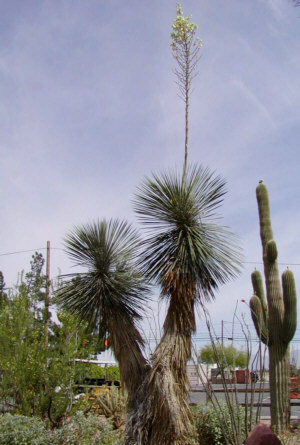

Soaptree
Yucca
Yucca elata

| The
Soaptree yucca is a perennial plant of the yucca family Agavaceae. They
commonly grow in Southwestern North America, in the Sonoran and Chihuahuan
deserts of Texas, New Mexico, Arizona and northern Mexico. This plant
grows from 10-18 ft, including the flower stalk. The white, bell-shaped
flowers grow to 2" long and are creamy white. They grow in clusters along
the tall flowering stalk. The flowering stalk is twig-thin and shoots
up from a bottom bundle of leaves. The triangular leaves are long, narrow
and palm-like; they grow at the base of the plant. The trunk is brown
and cylindrical in shape, often having holes drilled by escaping Yucca
moth larvae. The Soaptree yucca's fruit appears on the flower stalk. Each fruit is a brown capsule until the summer, when it splits into three sections that contain black seeds. They do not flower every year. These plants fare best in dry, semi-desert conditions. They are very cold-hardy, but need lots of sunlight. Native Americans used the fiber of the Soaptree Yucca's leaves to weave baskets. Inside the trunk and roots of the plant is a soapy substance high in saponins. In the past, this was commonly used as a substitute for soap and shampoo. Also, in times of drought ranchers have used the plant as an emergency food supply for their cattle. |